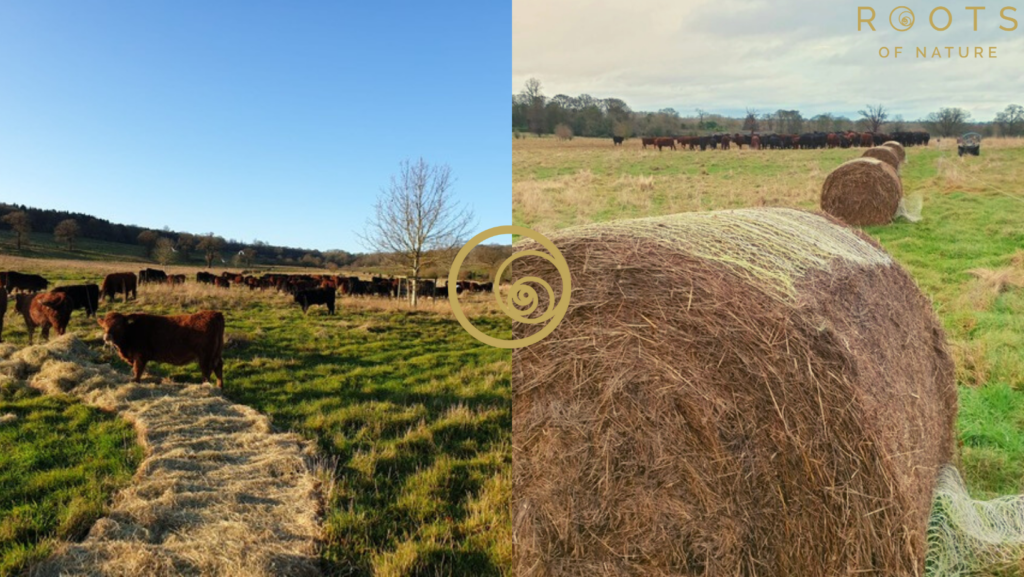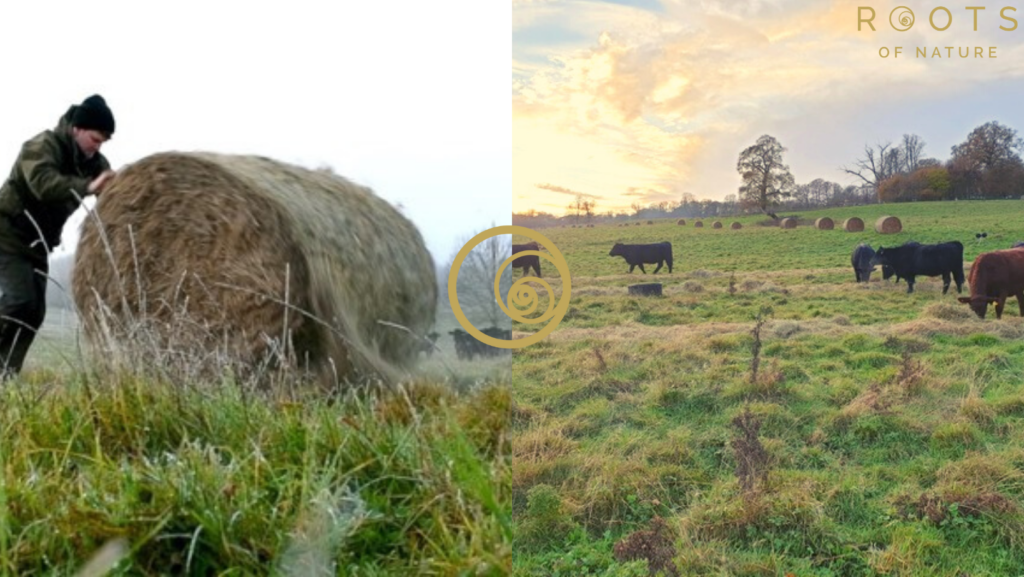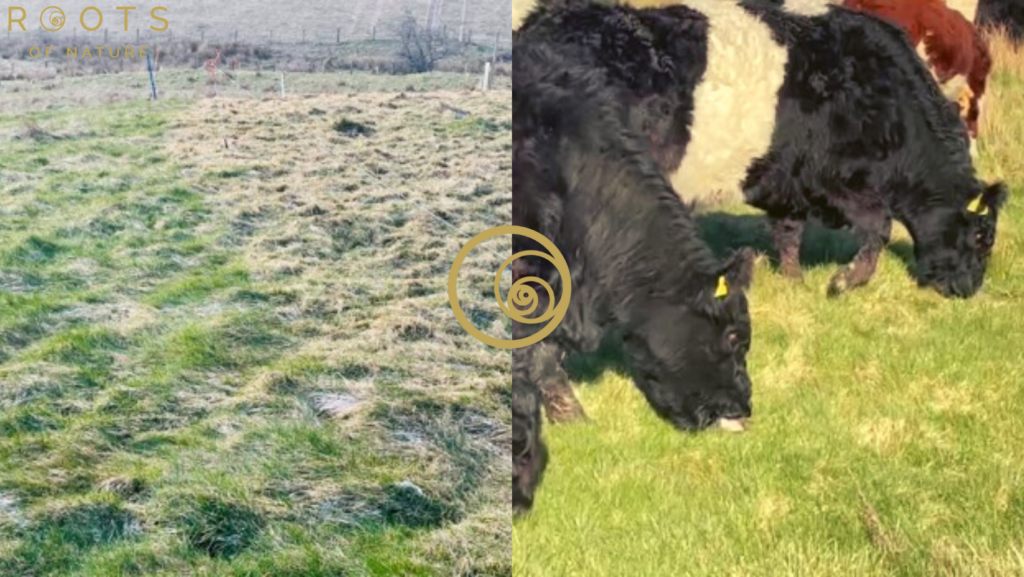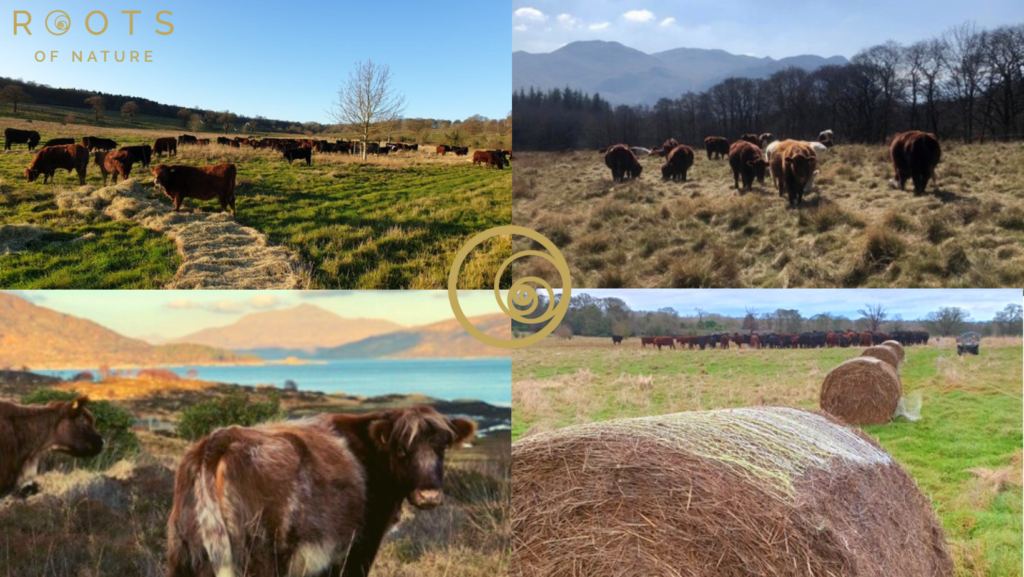Outwintering cattle is key for resilience in regenerative livestock farming.
By Georgia Wingfield-Hayes
“My most common, ‘It will never work on my farm’ comment, used to be about out-wintering.”
Clare Hill, Former Manager of Wytham, FAI’s Farm in Oxfordshire.

FAI’s farm Wytham, in Oxfordshire, has seen many changes over the past 5 years since they first trained with Caroline and adopted a regenerative approach to their livestock operations. Now the whole farm is under permanent pasture, cover crops and herbal leys supporting a suckler herd and dairy stores managed in two separate groups.
All but half the dairy stores are now out-wintered on the farm. “We’ve kept half of them inside to compare how the two groups do,” Silas Hedley-Lawrence, the farm manager told me. “They’ve been bought in from an intensive system, so we weren’t sure how they would fare, but it’s looking like the ones outside are doing slightly better.”
Like Clare, when I first heard talk of out-wintering it sounded like a great idea that probably wouldn’t work. So it’s been exciting to catch up with various farmers in different parts of the country, and hear how this is revolutionising farm life. Not only is it improving the quality of the farming experience, but it is knocking on the head the need for almost all fertiliser, feed, fuel and farm machinery.
“Out-wintering won’t work if you do it badly – and so few farmers now know how to do it well. It’s not rocket science – but needs proper methods.”
James Rebanks, Matterdale, Cumbria.
The How and Early Mistakes
I gather from Silas, James Rebanks and Sam Beaumont at Gowbarrow Hall Farm, in the Lake District, that the mistake commonly made in the first year of out-wintering, is to run out of fodder too soon. This means you have to use the spring grazing early and hammer it too hard, which can set the whole year awry.
Silas describes how in July he made detailed mathematical calculations on just how much feed the herd would need to get through to spring. The suckler herd at Wytham, around 90 cows and heifers and 65 calves at foot, spend the winter on ’The Park,’ 76.5 hectares of permanent pasture. After being briefly grazed in July, this land is closed off to stockpile grass.
The area is divided into 161 cells of around 0.4 ha each, with 4 round bales in each cell, which were placed there in the summer. The herd is moved onto a new cell every day, and the bales are rolled out.
“The hay doesn’t just feed to cows, we want some left on the ground to be trampled in, to build soil carbon.” Silas told me. “In terms of improvement in soil health, fertility and biodiversity, The Park is performing perhaps better than anywhere else on the farm.” He went on to explain that this is because this land gets the most consistent and effective use of the regenerative tools of animal impact, grazing and rest. “The cows can’t return to where they have grazed, so we get just the right amount of trampling, pushing the dry material into the ground and creating some bare soil,” continued Silas.

The hay used for bale grazing in The Park comes from the farm’s SSSI meadow by the River Thames. It is full of the seed from the 130 different species of plants found there. However Silas believes that the incredible burgeoning of diversity in The Park, might also come from a latent seed bank in the soil. “Other fields, even those that had a lot of moss and poor grasses are now full of wildflowers: pyramid orchids, oxeye daisies, red and white clovers… everywhere is a sea of colour,” he enthuses.
Silas is amazed by the scale of the transformation in such a short time, but believes it is happening more quickly, evenly and densely in The Park, because of the out-wintering regime.
An Economic No Brainer
One of the most compelling aspects of out-wintering is how it changes the nature and economics of farming entirely.
“My time was taken up driving a tractor which is very isolating, it’s not good for a farmer. You don’t interact with the animals either.”
Sam Beaumont, Gowbarrow Hall Farm, Ullswater, Cumbria
When Sam and his wife Claire took over Gowbarrow 4 years ago they were doing things very differently. “We were spreading fertiliser 3 times a year. The cattle were fed hay from September and housed from November. I was mucking out 2 times a day, feeding hay 2 times a day, then the muck spreader needed emptying every third day…”
Since undertaking a Wilderculture course and adopting a Wilderculture approach to their farming enterprise, winter is now a peaceful time at Gowbarrow, Sam generally goes up to the herd each day on foot. “It’s much more mindful walking, than being on a machine. You can observe the animals and how they behave. To them the quad bike means something, ‘we’re being moved’ or ‘being fed,’ but on foot you can walk right up to them and give them a scratch.”
At Gowbarrow the approach to wintering is more akin to rewilding where the cattle are able to roam freely along with four ponies and four pigs in a large area of upland wood pasture. The farm is managed in two blocks; the summer block and the 100 hectare ‘park’ which is the winter block.
Regenerative planned grazing is used in the summer block between April and December which is made possible by not needing to make much hay or silage on this meadow land. This management allows the winter block to fully rest and recover during the growing season, building a reserve of winter feed for the cattle when they go up in November/December time.
In the summer Sam set out just 20 round bales in an area that is fenced, so access can be controlled. This supplementary feed is an insurance policy, to buy time in March and April when fodder is losing quality or can run short for a time when the nutritional needs of the cattle are high as they move towards calving in May. Otherwise his 46 cows have lived the whole winter on The Park’s stockpiled grass, and they look very well on it too.

“I’ll never keep cattle in a shed again as long as I live… I love this system.”
James Rebanks, Matterdale, Cumbria
On James Rebanks’ farm in Matterdale, in the Lake District, he has also developed an out-wintering system on 27 acres, for his 10 Belted Galloway Cow with followers. He starts preparing the fields in March in order to build the plant roots, thatch and older material. Then the area had one brief graze/trample for 3 days in August.
In winter he moves his cattle two, sometimes three times a day which saves a fortune in hay. “These cattle can eat a £30 hay bale in a day… and a 7 acre field has carried them for 30 days – no building, no tractor, no haulage, no muck spreader, no fertiliser, no muck handling, no straw, no bought feed, no medicines, and soil and grass that is in amazing health – all they get is one small hay bale worth £3 a day.”

Back at Wytham in Oxfordshire, Silas enthuses in a similar way about the savings made with outwintering. “I don’t really need to tell you what a huge difference it’s making. Nature and soil biology gives us all the productivity we need. Now we are not subject to market price volatility and whatever else is going on in the world. When your soils become biologically functional with more carbon, there’s greater cation exchange and plants produce more sugars.” Silas told me. “Plus the pastures are much taller, so we don’t need to worry about drought.”
At Wytham they follow a general rule of grazing only 25-30% of the sward height in spring, 50% in summer and 75% in winter. This taller pasture is why the farm is so much more drought resistant. The complex soils ecology hugely increases the soil’s ability to capture and store rainfall. The whole system is far more resilient and healthy, as are the cows. Their fertility runs at 95-98% and they have no calf mortality.
Having the calves with the cows through the winter saves money, because the cows turn low quality forage into high nutrient milk. They are also then in good condition to go back into calf in spring.
Outwintering it seems is key in regenerative farming with livestock in order to achieve true resilience where we no longer have to depend on expensive artificial fertilisers, bought in feeds, machinery and fuels. It frees up time for other things, improves the quality of life for humans and animals alike and fosters a place for nature, as biodiversity returns to our farming landscape.
If you want to learn more about how outwintering could be a great addition to your grazing system then there are several ways to learn more.
- Outwintering: An out and out success. An open day at FAI farms Wytham where you can meet Silas, Caroline and the whole team to learn about all of the potential benefits and challenges of adopting an outwintering system on your farm.
- Grazing School – learn all about building a regenerative grazing plan from Caroline and James, held twice a year on James and Helen’s farm in the Lake District.
- Wilderculture basic training. Learn from Sam and Caroline through a combination of self-led online learning and a visit to Wilder Gowbarrow. Several dates throughout the year.
